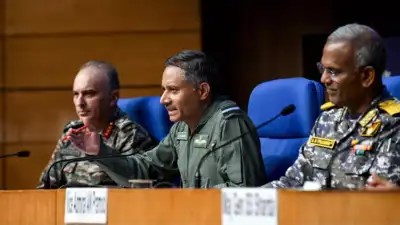
India, Pakistan Hold DGMO-Level Talks on Border Issues

 :
| Updated On: 28-May-2025 @ 3:08 pm
:
| Updated On: 28-May-2025 @ 3:08 pmSHARE
India and Pakistan held their routine weekly Director General of Military Operations (DGMO)-level talks on Tuesday through the established hotline between their respective military offices. These discussions are part of ongoing efforts to manage border tensions and maintain the ceasefire agreement that was put in place on May 10. During this latest exchange, both sides discussed “border management issues,” with a focus on reducing troop presence along the border and forward areas. These weekly communications, conducted by mid-level officers, are standard protocol and are held every Tuesday to maintain transparency and stability.
The current ceasefire was agreed upon between Indian DGMO Lt. General Rajiv Ghai and Pakistani DGMO Major General Kashif Abdullah following a brief but intense spike in hostilities that began on May 7. It was only after the understanding reached on May 10 that hostilities were brought under control. Both nations have since been working on confidence-building measures (CBMs) to gradually reduce high alert levels and ensure that neither side engages in aggressive or provocative actions.
This understanding, however, is not unconditional. It came into effect following India’s strategic precision strikes on May 10 against nine Pakistani airbases and several radar installations. These strikes were a response to the deadly terror attack in Pahalgam. India has made it clear that the ceasefire is conditional and directly tied to Pakistan’s behavior. Defence Minister Rajnath Singh reiterated that any further provocations or disturbances from Pakistan would be met with a strong and immediate response. "If Pakistan's behaviour improves, it is fine. But if there is any disturbance, harshest punishment will be given," Singh had stated.
Following the Pahalgam attack, Pakistan mobilized several reserve army formations, moved tanks, and deployed Chinese-manufactured SH-15 155mm self-propelled howitzers close to both the Line of Control (LoC) and the international border. This military build-up was seen as a direct provocation and escalated tensions significantly. In response, India enhanced its own security posture by conducting forward deployments and activating a comprehensive multi-layered air defence network. This system played a critical role in intercepting and neutralizing drones and missiles launched by Pakistan targeting Indian civilian and military facilities.
The two sides continue to engage diplomatically and militarily to stabilize the situation, but India maintains a firm stance that any future peace will be contingent on Pakistan curbing terror activities and respecting the terms of engagement. The DGMO hotline remains a crucial communication channel in preventing misunderstandings and ensuring that the ceasefire holds.
In summary, while both India and Pakistan are currently engaged in regular military-level dialogue to ease border tensions, the ceasefire agreement remains fragile and dependent on Pakistan’s conduct. India’s robust defensive and offensive military actions following the Pahalgam incident underscore its zero-tolerance policy towards terrorism and its preparedness to safeguard national interests. The ongoing DGMO talks are aimed at preserving the fragile peace and preventing a return to open hostilities.
Contact Us
House. No. : 163, Second Floor Haridev Rd, near Puberun Path, Hatigaon,Guwahati, Assam 781038.
E-mail : assaminkcontact@gmail.com
Contact : +91 8811887662
Enquiry
×
Reporter Login
×